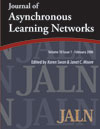AN ADMINISTRATOR’S GUIDE TO THE WHYS AND HOWS OF BLENDED LEARNING
DOI:
https://doi.org/10.24059/olj.v14i1.1641Keywords:
Blended Learning, Hybrid Courses, Institutional Change, Degree Completion, Assessment and Evaluation, Sustainability and ScalabilityAbstract
Given the importance of administrative attention to blended learning, this article adumbrates the institutional benefits but also the institutional challenges of this integration of online and on-campus instruction. The reasons for engaging in blended learning determine how it will play out, so the why is given precedence over the how. But there is an attempt to elaborate the methods even more extensively than the reasons, to drill down into the considerations that must be taken into account in any successful implementation. Just how the details will sort out will necessarily vary from one institution to the next, but there are certain considerations that seem genuinely indispensable, the keys to success or failure, sustainability or aborted effort.
References
Picciano, A. G. Blending with purpose—The multimodal model. Presentation at The Sloan-C Workshop on Blended Learning, Chicago IL, 2008.
Hauptman, A. M. Participation, persistence, and attainment rates: The US standing. International Higher Education 52: Summer 2008. http://www.bc.edu/bc_org/avp/soe/cihe/newsletter/Number52/p19_Hauptman.htm Accessed July 25, 2008.
Garrison, D. R. & H. Kanuka. Blended learning: Uncovering its transformative potential in Higher Education. The Internet and Higher Education 7(2): 95–105, 2004.
Otte, G. (2005). Using blended learning to drive faculty development (and vice versa). In J. Bourne and J. C. Moore (Eds.), Elements of Quality Online Education: Engaging Communities. Needham, MA: Sloan Consortium, 2005.
Young, J. R. ‘Hybrid’ teaching seeks to end the divide between traditional and online instruction. Chronicle of Higher Education 3/22/02: A33, 2002.
Dziuban, C., J. Hartman, F. Juge, P. Moskal & S. Sorg. Blended learning enters the mainstream. In C.J. Bonk & C. R. Graham (Eds.), The Handbook of Blended Learning: Global Perspectives, Local Designs. San Francisco: Pfeiffer, 2005.
Laumakis, M., C. Graham & C. Dziuban. The Sloan-C Pillars: Boundary objects as a framework for evaluating blended learning. Presentation at The Sloan-C Workshop on Blended Learning, Chicago IL, 2008.
Downloads
Published
Issue
Section
License
As a condition of publication, the author agrees to apply the Creative Commons – Attribution International 4.0 (CC-BY) License to OLJ articles. See: https://creativecommons.org/licenses/by/4.0/.
This licence allows anyone to reproduce OLJ articles at no cost and without further permission as long as they attribute the author and the journal. This permission includes printing, sharing and other forms of distribution.
Author(s) hold copyright in their work, and retain publishing rights without restrictions






